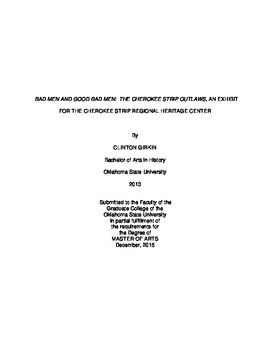| dc.contributor.advisor | Bryans, William | |
| dc.contributor.author | Girkin, Clinton | |
| dc.date.accessioned | 2017-02-22T22:12:36Z | |
| dc.date.available | 2017-02-22T22:12:36Z | |
| dc.date.issued | 2015-12-01 | |
| dc.identifier.uri | https://hdl.handle.net/11244/48978 | |
| dc.description.abstract | This project proposes a museum exhibit that will explore the nature of outlawry and the public�s response to it. The introductory chapter will explain the public�s perception of outlaws. Richard Aquila argues that the public believes that outlaws represent both honorable and dishonorable aspects of the West. This thesis will argue that the nineteenth-century�s perception of outlawry affected the twentieth and twenty-first century�s perceptions. The stereotypes related to outlawry are not new. The thesis will specifically assert that actual outlaws were more complex than the �noble criminal� or �bad men� stereotypes. Many outlaws were �noble criminals� and �bad men� at the same time. The Cherokee Strip�s outlaws provide an excellent case study for the complex nature of outlawry. Outlaws who operated outside the Cherokee Strip were similar to the Cherokee Strip outlaws in many ways. The second chapter will begin by explaining the nature of the Cherokee Strip and why that region was notorious for the crimes committed in that region. The bulk of the second chapter discusses each of the region�s most notorious gang�s activities and reception. The most-publicized outlaws of the region were the Dalton Gang, the Doolin-Dalton Gang, the Wyatt-Black Gang, Cattle Annie, Little Britches, the Rose of the Cimarron, Ben Cravens, Nate Sylva, and the Jennings Gang. A few of these outlaws actively contributed to Western fiction and influenced the genre. These outlaw�s contributions to cinema and literature are also discussed in chapter two. After considering the Cherokee Strip�s outlaws, the chapter focuses on outlaws who operated in other parts of Indian and Oklahoma Territory. This section argues that these outlaws had positive and negative traits that heavily resembled the Cherokee Strip�s outlaws. The third chapter explains how objects can teach visitors the reality and legends associated with outlawry. Various weapons, photographs, wanted posters, newspaper articles, films and other materials provide insight into the outlaw�s complex codes of honor. Chapter three examines how the exhibit will interpret the artifacts. | |
| dc.format | application/pdf | |
| dc.language | en_US | |
| dc.rights | Copyright is held by the author who has granted the Oklahoma State University Library the non-exclusive right to share this material in its institutional repository. Contact Digital Library Services at lib-dls@okstate.edu or 405-744-9161 for the permission policy on the use, reproduction or distribution of this material. | |
| dc.title | "Bad Men and Good Bad Men: The Cherokee Strip Outlaws," an Exhibit for the Cherokee Strip Regional Heritage Center | |
| dc.contributor.committeeMember | Arata, Laura | |
| dc.contributor.committeeMember | Moses, L. G. | |
| osu.filename | Girkin_okstate_0664M_14388.pdf | |
| osu.accesstype | Open Access | |
| dc.description.department | History | |
| dc.type.genre | Thesis | |
| dc.type.material | text | |
